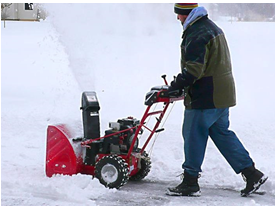Walk behind Snow Blower SWP

Summary: The walk-behind snow blower is used for clearing accumulated snow from sidewalks and walkways by picking it up and propelling it off to the side
Hazards:
· Noise
· Cold
· Slips, trips, falls
· Flying debris
· Entanglement
· Amputation
· Traffic and mobile equipment
· Strains
· Fumes
· Burns
Personal Protective Equipment (PPE) Required:
· Safety footwear with adequate grip
· High-visibility apparel
· Eye protection
· Hearing protection
· Gloves
· Adequate winter clothing
Pre Set-Up:
- Read, understand, and follow instructions on the machine and in the operator’s manual
- Be familiar with all controls and their proper operation
- Inspect the machine before use
- Follow safety guidelines in manual when adding fuel
- Inspect the area where the machine is to be used – remove or avoid any foreign objects that could be thrown by the auger/impeller
- Ensure that collector housing height is adjusted to clear gravel or crushed rock surfaces
- Disengage all control levers before starting the engine
Task procedure:
- Use required PPE
- Keep hands, feet and clothing away from rotating parts in the auger/impeller housing or chute assembly
- Ensure that discharge is not directed towards bystanders, windows, vehicles, etc.
- Do not allow other people in front of the machine while it is operating
- Use extreme caution if operating on or crossing gravel surfaces
- Be aware of vehicles or traffic around you
- Surfaces will likely be slippery – move deliberately
- If the discharge chute becomes clogged:
a. Shut the engine off
b. Wait 10 seconds to be sure the impeller blades have stopped rotating
c. Always use a clean-out tool, not your hands, to clear the blockage
- If the machine strikes a foreign object or begins to vibrate abnormally, stop the engine, disconnect the spark plug wire and ground it against the engine. Inspect thoroughly for damage and make repairs before operating again
Post-Procedure:
- Disengage all control levers and stop engine before leaving the operating position
- Clean machine and inspect for wear or damage
- Report any needed repairs to Mechanics
